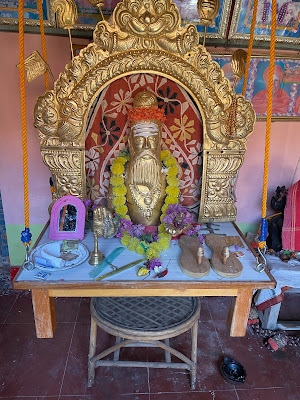Today, we will delve into the intriguing history of Jadigenahalli, a village located 30 kilometers from Bangalore in the southern Indian state of Karnataka. During the Census conducted by the Directorate of Census Operations, it was revealed that this village has been inhabited by humans since as early as 4,000 B.C, which corresponds to the Middle Stone Age. Archaeological excavations in Jadigenahalli, as well as in nearby locations like Jalahalli, Sudasandra, and Siddhapura, have unearthed stone implements from this ancient period, shedding light on the early human settlements in the region.
The folklore of our land is rich with tales of love, loyalty, compassion, and dedication. Within the serene surroundings of this ancient temple, encompassed by vibrant rose gardens and flourishing daffodil farms, a captivating story unfolds, as narrated by the temple priest.
Centuries ago, after the establishment of this temple, a woman named Malamma found herself deeply enamored with Kalabhairava, a form of Lord Shiva. She embarked on a journey of intense spiritual discipline, hoping to wed God himself. In response to her devotion, Lord Kalabhairava appeared before Malamma and expressed his commitment to the path of Brahmacharya, renouncing worldly relationships. Although he could not reciprocate her romantic feelings, he blessed her with a divine boon. In her subsequent life, Malamma would be worshipped as Lord Kalabhairava's sister. In her new birth, Malamma grew into a remarkable woman, eventually getting married and becoming a mother. One day, while traveling with her newborn child to visit her mother, fate led her to cross paths with this very temple. It was during this profound moment that Malamma realized the true purpose of her existence. She embraced her destiny and merged with the divine idol, accompanied by her newborn child.
As the temple priest concluded this enthralling tale, it evoked parallels to the legends of Sabarimala and Tiruppavai, the Tamil Hindu hymn composed by the revered female poet-saint Andal. Such stories resonate with the enduring power of love, devotion, and spiritual transformation, inspiring generations to seek divine union and find profound meaning in their lives.

Let's delve into the intricate schematics of this sacred place. At the heart of the temple lies the primary deities, Kalabhairava, Goddess Malamma, and her child, reside. Within this sacred space, a small Lingam and a Nandi guarded by by Bootaraya and Bootaraksha. Moving into the antarala we see Lord Ganesha guarded by Bhringi and Jati. The Mandapa is supported by pillars embellished with exquisite carvings. These carvings depict various divine figures and scenes, such as Kamadhenu, Maha Vishnu, an elephant performing abhishekam of the Shiva Lingam (reminiscent of Thiruvanaikoil Temple History), Lord Hanuman, Lord Ganesha, different forms of Devi, and musicians holding Damaru and Veena instruments.
As one enters the temple, the entrance is guarded by Jaya and Vijaya, celestial gatekeepers. Moving along the outer walls of the temple, carvings of fishes and snakes can be seen, adding a touch of symbolism and mysticism. The Dhvajastambha, the flagstaff pillar, stands tall with its own intricately carved designs. It features carvings of the Trishul (trident), Chakra (discus), Ganapathy, and Eshwara, representing the divine forces and cosmic energies. Additionally, one can find unfinished stone pillars that appear abandoned, remnants of an ancient time, adding an air of mystery and intrigue to the surroundings.
Certainly! It's important to clarify that the opinions expressed below are solely my own. These views are not influenced by any external factors or sources, and they are presented from my personal perspective. Please consider them as subjective opinions and feel free to form your own conclusions based on the information provided.
It is said that this temple is built by the Chola kings and abundant treasures were buried underneath the temple. True to that the inscriptions on the temple walls appears to have been damaged, scratched or erased off. The main deity's identity also seemed to be questionable since according to Shaivism Bhairavi is the consort of Kalabhairava and this would disqualify the tale associated with Malamma. Normally in Shiva temples, idols of Bhairava are situated in the north, facing Western direction. In this temple the idol faces Eastern direction which is not considered to be good and it is also to be noted that here he neither has a Danda nor appear with a dog.
Let's explore the possible identity of the main deity at this temple. Fish symbolises fearlessness, happiness, and fertility while the Naga or snake is a symbol of fertility and water in Hindu religion. Observing the Gopura, we can see that it is embellished with various representations of Hindu goddesses. At the entrance, the main deity is depicted as a nurturing figure, closely resembling Goddess Shashti or Goddess Manasa who are associated with vegetation and reproduction, believed to grant blessings of fertility and aid during childbirth. It is speculated that the name could have originated from either "Mane Manchamma" of the Mandya region or "Mudama" of the Mysore region. These village deities were worshipped by devotees to seek protection from snake bites during rainy season when snake activity increases. Hence in my the opinion the story of Malamma doesn't seem to stand out and that the recreation or modification of the main deity's identity could have happened due to various reasons, such as changes in religious practices, cultural influences, or local traditions with the intention of preserving the sanctity and spiritual significance of the temple. This concludes my interpretation.
In summary, the temple's history, including its origins, inscriptions, and restoration, can involve various perspectives and interpretations. To ascertain the true historical context and significance of the temple, further research combining archaeological evidence, historical records, and expert analysis would be necessary.
இடம்: ஸ்ரீ காலபைரவர் கோவில், ஜடிகேனஹள்ளி











